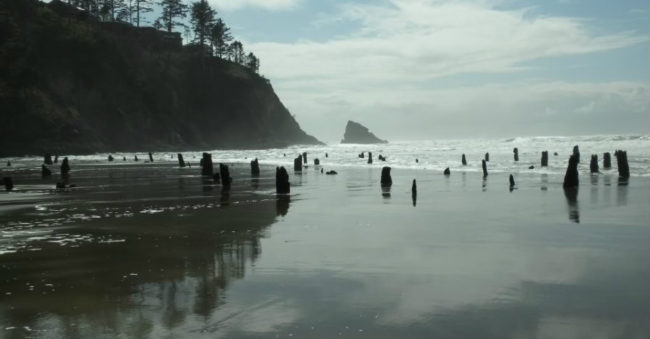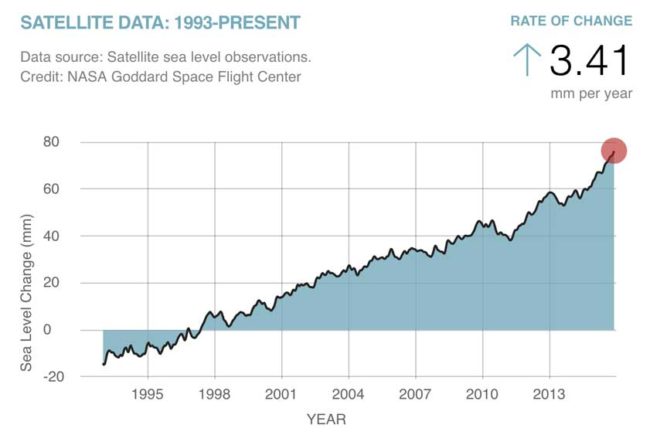
There is an associated press article that has initiated a series of media articles about what are called ghost forests.
Let’s start by defining what the term “Ghost forest” actually means and what causes this to happen. Basically, when sea level rises after an earthquake or due to climate change, a forested coastal region can become inundated with sea water. This of course kills the trees and so it leaves behind what is termed a “Ghost Forest”. In the Pacific Northwest there are examples that are the result of tectonic activity within the Cascadia Subduction Zone. Roughly every 500 years or so the tension that has built up gets released and leads to subsidence. The net effect is that an elevated coastline will suddenly drop several meters to below sea level, and so a costal forest becomes inundated. A specific example of this is the Neskowin Ghost Forest on the Oregon coast (as pictured above).
The other root cause of a ghost forest is climate change, and so it is this that the associated press article focuses upon. As climate change leads to sea level rise, the southern US coastal marshes are expanding into dry wooded areas. When forested land is at sea level, then this is the inevitable outcome of a rise in sea level.
Breitbart rebuttal
As a response to the various recent articles about the increasing growth of ghost forests within the southern US states being yet another clear symptom of climate change, Breitbart have attempted a rebuttal.
Brietbart has jumped in with the suggestion that it is just natural variability and that sea level is not really rising, but then this is Breitbart. If they are assuring you of something, then you can be more or less certain that it is not true. They repeat much of what the AP article says, and then try to dismiss it with this …
Many climate scientists have acknowledged the practical impossibility of correlating a specific meteorological or environmental phenomenon to “global warming.”
This is correct. For example, when one big storm happens you can’t attribute it to climate change. A specific isolated event may indeed be natural variability. It is important to understand that weather and climate are not the same thing. This however is not a viable or even a meaningful rebuttal. Sea level rise is not just one isolated event, nor is an increase in the growth of ghost forests in the southern US, both are clear long term trends that are going in a specific direction and are not single isolated weather related events. Mr Williams claims within his Breitbart article that attributing these trends to climate change is dishonest. Unfortunately the evidence is rather clear, sea level really is rising, and has been doing so for many decades. The root cause is climate change, to claim anything else is dishonest … but hey, this is Breitbart, I expect nothing less than dishonesty, it is part of their brand.
Is Sea Level Real Rising?
Let’s briefly review this. I’ve covered it before in recent months …
- May 2017 – New Study: The rate of Sea level Rise has tripled since 1990
- May 2017 – US Interior Department has no idea why sea level is rising
- April 2017 – Sea level rise projections have been revised upwards
In essence, yes, sea level is not only rising, but the rate is accelerating …
Sea Level is rising. As illustrated above, it is been slowly doing so for some time, this is a measurable verified fact. If you ever wondered if there was some unambiguous clear decisive evidence that the world truly is warming then this is it. Crack open the Wikipedia page on the topic and you will read some truly scary stuff …
Because of the slow inertia, long response time for parts of the climate system, it has been estimated that we are already committed to a sea-level rise of approximately 2.3 metres (7.5 ft) for each degree Celsius of temperature rise within the next 2,000 years.[4] IPCC Summary for Policymakers, AR5, 2014, indicated that the global mean sea level rise will continue during the 21st century, very likely at a faster rate than observed from 1971 to 2010.[5] Projected rates and amounts vary. A January 2017 NOAA report suggests a range of GMSL rise of 0.3 – 2.5 m possible during the 21st century.[6]
Ghost Forests
So finally, back to that AP report. Here are a couple of quotes from subject matter experts that I’ve gleaned from it …
“I think ghost forests are the most obvious indicator of climate change anywhere on the Eastern coast of the U.S., It was dry, usable land 50 years ago; now it’s marshes with dead stumps and dead trees.” – Matthew Kirwan, a professor at Virginia Institute of Marine Science who is studying ghost forests in his state and Maryland.
“There is a lot of change going on, It’s dramatic and it’s changing faster than it has before in human history.” – Greg Noe, a research ecologist with the U.S. Geological Survey.
… but perhaps the best way to finish is with this rather stark reality check …
Quantifying the rate of increase in ghost forests is a major focus of Able’s research. Some scientists say the increase began around the time of the Industrial Revolution, while others say the speedup began more recently than that.
In the past 100 years, Kirwan said, 100,000 acres of forest in the Chesapeake Bay has converted to marshland. Photographs show the rate of coastal forest loss is four times greater now than it was during the 1930s, he said.
Seas off the East Coast have risen by 1.3 feet over the last 100 years, said Ben Horton, a Rutgers University professor and expert on sea level rise. That is a faster pace than for the past 2,000 years combined, he said.
Some of the most dramatic anecdotal evidence of the acceleration in ghost forest creation is along the Savannah River between Georgia and South Carolina, Noe said.
When his team first got there 10 years ago, “it looked like the trees were under a little stress, but they were all alive,” he said. “But five years later, the vast majority of them were dead. That happened right in front of our eyes, much faster than we expected.”

